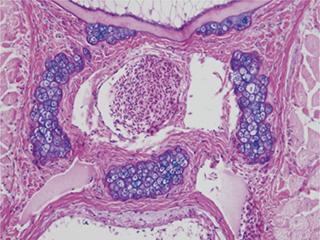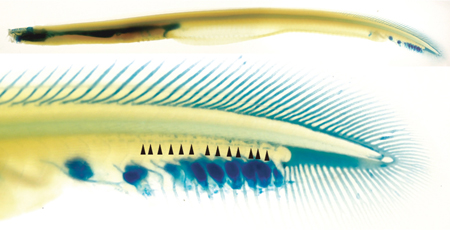| RIKEN Center for Developmental Biology (CDB) 2-2-3 Minatojima minamimachi, Chuo-ku, Kobe 650-0047, Japan |
July 1, 2011 –The earliest roots of the phylum Vertebrata trace back more than 500 million years, to the appearance of the body plan characterized by the vertebrae for which it is named. Hagfish, cartilaginous jawless fishes that lack bony vertebrae, have thus sometimes been excluded from the vertebrate ranks, despite sharing many characters with other vertebrates. In such schemes, they are technically invertebrates but are classed together with vertebrates as ‘craniates,’ referring to their well-developed craniums. The debate about hagfish’s true taxonomic place has raged for more than a century, but is their lack of bony elements enough to leave them an evolutionary odd man out?
Vertebra-like cartilaginous nodules had in fact been found in hagfish over a century ago, but these were nearly forgotten. Kinya G. Ota and colleagues in the Laboratory for Evolutionary Morphogenesis (Shigeru Kuratani, Group Director) have now conclusively shown the presence of these elements and analyzed their anatomical features as genuine vertebrae in the Japanese in-shore hagfish, Eptatreus burgeri. They further identified true vertebra-like traits in embryonic hagfish developmental patterns and processes, although these are for the most part lost in the adult. Reporting in Nature Communications, the group suggests that the hagfish are, along with the lampreys, indeed true members of the cyclostomes. Ota’s work was enabled by the lab’s access to hagfish embryos for anatomical and histological analyses, something that only became possible when the Kuratani lab succeeded in breeding the animals in captivity several years ago. Building on this achievement by developing a long-term incubation system, Ota gained access to a sufficiently large number of fertilized eggs to investigate their development at multiple stages. The early pharyngula-stage hagfish was found to develop just under 80 somites, the repeating structures along the anterior-posterior axis of the embryo that in most vertebrates serve as the primordia for many of the bones and skeletal muscles in the trunk. Looking at gene expression in the somatic region of the trunk, Ota noted similarities in the expression of characteristic genes in patterns corresponding to those of jawed (gnathostome) vertebrates. Specifically, hagfish Twist and Pax1/9 were expressed in segmentally arranged ventral mesenchyme derived from the medial part of epithelial somites, while Pax3/7 and MyoD were respectively switched on dermomyotome and myotome, respectively, indicating that this stage of hagfish somitogenesis follows a similar routine for the formation of somite-derived muscle and skin to that in later vertebrates. By the late pharyngula stage in hagfish, an additional dozen or so somites have formed, including those that give rise to vertebra-like elements at around somite 90. The group found that the Pax1/9 expressing cells at this stage had become more broadly distributed, suggesting that some had migrated further ventrally, and might thus correspond to the sclerotome in later vertebrates, which is the somitic component that gives rise to the vertebrae.
Given these similarities, the group surmised that hagfish somites indeed form both dermomyotome and sclerotome, indicating homology with other vertebrates. And indeed close examination of the adult anatomy yielded cartilaginous axial elements to either side of the dorsal aorta that may represent the hagfish’s vertebra-like equivalent. Although these cartilages lack the metameric quality of true vertebrae, their location and arrangement within the body are reminiscent of ventral components of gnathostome vertebrae known as the neural spine and neural arches.
| |||||||
|
|||||||
 |
| Copyright (C) CENTER FOR DEVELOPMENTAL BIOLOGY All rights reserved. |

